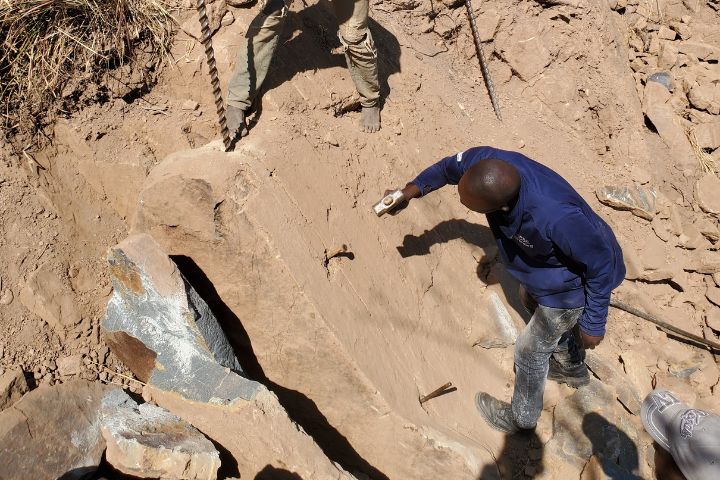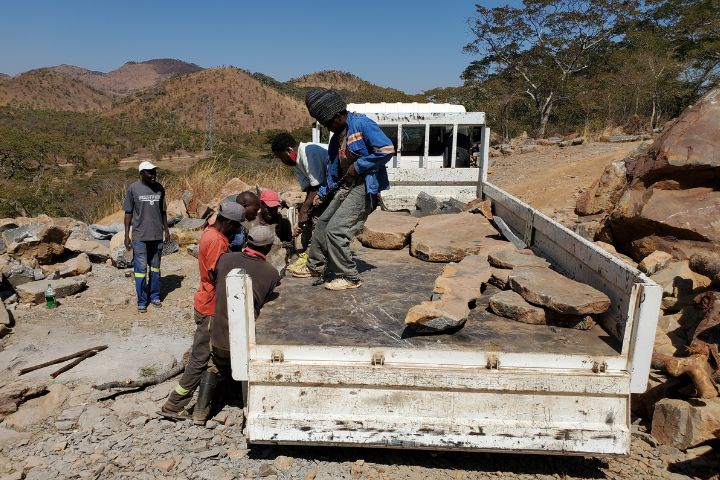
A Springstone mine in Zimbabwe
Driven by a profound connection to the craft of stone carving, I explored a springstone quarry during one of my visits to Zimbabwe. When I create sculptures or design them for other artists to sculpt, I prefer to handpick the stones. I enjoy selecting rocks based on the specific shapes I'm envisioning. Initially, I relied on miners who would return from the mine with a pile of stones. These were essentially the leftovers - the extras brought back in case any artist might find them suitable for their creative visions.
As time passed, I felt the urge to be more directly involved in the selection process. I began visiting the mine, exploring the hills, and discovering a more diverse selection of stones. The opportunity allowed me to connect directly with the source and immerse myself in the abundance of rocks. There's something awe-inspiring about being in open spaces, surrounded by nature and the stones that will eventually become my art.
To truly appreciate Zimbabwean stone sculpting, one must grasp the laborious and innovative mining process that underpins this remarkable art form.
The Mining Process
Mining for carving stones is no small feat. It's a labor-intensive process where miners depend on hand tools to dig pits and extract rocks.
Guided by artists' specifications, miners inspect the raw stones for quality and potential, carefully selecting rocks based on their size and shape.
The miners' dedication to this process is crucial, as it's only due to their efforts that artists have the materials needed for their work.

Miners with one of the handpicked springstone rocks
Ingenious Solutions
Without heavy machinery, miners implement creative techniques to overcome the challenges of manually excavating the heavy rocks.
Rock Fragmentation
Some rock formations are so large that the miners must break them apart before removing them from the pit. Fragmenting massive boulders is a challenging task that typically requires specialized equipment like explosives or hydraulic splitters.
Armed only with hand tools, miners rely on their resourcefulness. They meticulously hammer large pins, spaced approximately 20 cm apart, into the rock's surface. As they strike each nail, cracks form and deepen, breaking the rock into manageable pieces.

Miners hammering pins into a large rock
Dislodging the Rocks
Even after dismantling the colossal rock formation, the resulting boulders are still bulky, with some standing as tall as the miners. Getting the heavy rocks out of the pit requires an innovative pulley system. This system consists of a chain securely fastened to the rock, with the midpoint of the chain connected to a specially designed pulley apparatus anchored to a sturdy tree at a strategic point outside the pit.
The pulley itself is ingeniously crafted from repurposed tractor components. I'm not mechanically inclined, so I can't specify the exact tractor part they used, but I observed that it featured a turning wheel to which they could securely strap the chain.

A miner using a pulley system, ingeniously designed from a tractor part, to extract a rock from a springstone mine
Loading the Rocks Onto the Truck
Typically, the mining pits are higher up the hill, while the trucks can only reach the base. Miners make bridges from logs to get the rocks from the upper slopes to the vehicle. They then slide or roll the boulders down the makeshift bridges and into the truck. The technique is reminiscent of how people moved rocks thousands of years ago.

Miners using logs to move large stones into a truck
Additional Challenges
Distance Dilemmas
The mine in the photo is approximately 4 to 5 hours from Tengenenge, where many artists reside. To transport the stones from the remote mine to the workshop, they must hire a driver and a truck, making this logistical aspect of the process quite challenging.

Stones loaded on the truck
Harsh Wilderness Conditions
The stone quarry is in the untamed wilderness and lacks modern conveniences. The environment can be unforgiving, with scorching temperatures and the occasional presence of snakes and scorpions. I once lifted a rock, and to my surprise, there was a massive scorpion under the rock. These conditions are a stark reminder of the dedication required to obtain the precious carving stones.

Truck at the bottom of the stone quarry mountain
Environmental and Ethical Factors
I often think about the environmental impacts of stone mining. While the process disturbs the bush, it's worth noting that it's not a protected game reserve, and its proximity to civilization means that the wildlife presence is limited, aside from a few snakes and scorpions.
Unlike vast mining operations for minerals like granite or copper, with mining pits large enough to fit a whole town, stone mining consists of small quarries and no heavy machinery, resulting in a relatively minimal environmental footprint. Additionally, the abundant reserves of stones in this area ensure the sustainability of this practice, with enough resources to last for hundreds of years.

Small stone mine
It's also important to consider the positive aspects of stone mining. It's how the artists earn a living and feed their families - by creating unique and beautiful art from these stones. In our next blog post, I'll touch on the adversity and resilience of Zimbabwean artists in greater detail. Stay tuned for more on this fascinating subject.
My entire experience at the mine was unforgettable. I'm like a kid in a candy store when I'm exploring the hills, looking for interesting shapes and colorations of stones. What aspects of the mining process intrigued you the most? I'd love to hear your thoughts and questions in the comments below.
